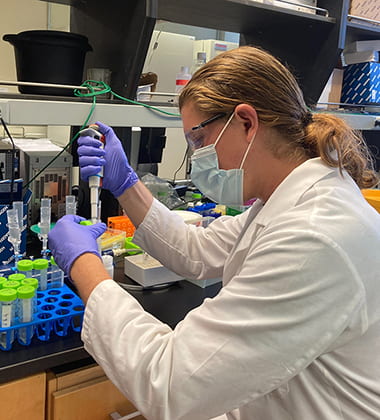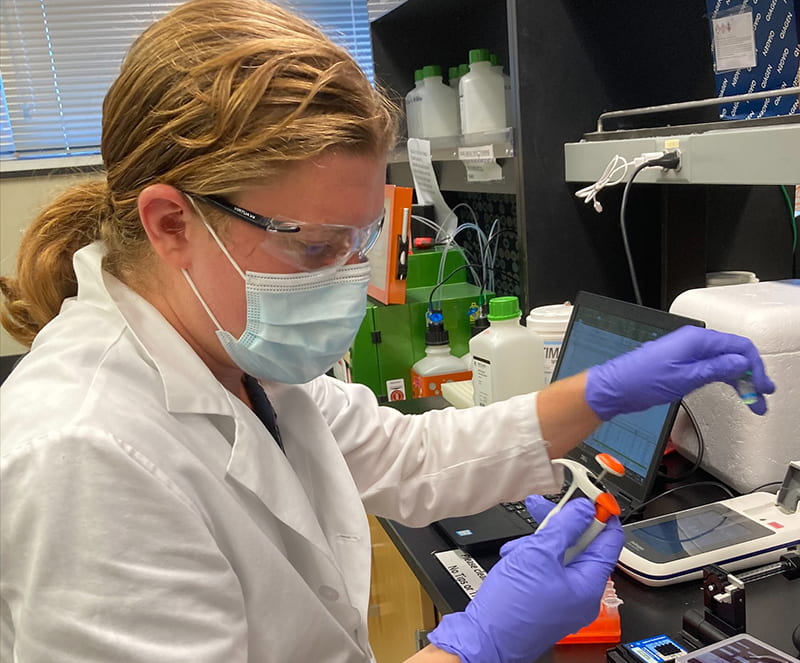Tell me about your background.
I grew up in fairly rural central Illinois, went to the local schools and was always interested in understanding science and medicine. I completed my undergraduate degree in neuroscience at Lake Forest College where I got my first experience with research through multiple summer research programs culminating in my Senior Thesis focusing on understanding mechanisms of familial alpha-synuclein toxicity in yeast models.
What led you to study at Washington University?
I was initially unsure whether to pursue medicine or research prior to my undergraduate research experience but found that research is my true passion and decided to pursue a PhD after consulting with my undergraduate advisor. I had heard quite a bit about Washington University but didn’t fully appreciate the research environment until the interview process compared to other Universities that I applied to. Washington University not only is an excellent research institution but is unmatched in the opportunity to collaborate between departments and with other groups. No where else I applied readily encouraged actively pursuing collaborations and jumping directly into research.
What are your future career goals?
Ideally, I would like to find a position where I have the opportunity to teach at an academic institution and continue the same type of research that I have been working on now. I try to be as flexible and open to what opportunities present themselves, and either being an independent PI or in collaboration with another lab would work great.

What are you working on right now?
The main focus of my research is developing and applying a liquid biopsy assay to differentiate a rare sarcoma (malignant peripheral nerve sheath tumor, MPNST) from a benign precursor tumor called plexiform neurofibroma. While these malignant tumors are rare in the general population, they occur in about 10% of patients with the cancer predisposition syndrome, Neurofibromatosis type 1, and are the leading cause of mortality in these patients. It is exceptional challenging to differentiate these tumors with current methods but crucial to do to improve outcomes for this relatively young population. I am working on developing a liquid biopsy assay using circulating tumor DNA to distinguish patients with MPNST from plexiform patients. Ideally, this should help detect malignant transformation early, profile tumors for actionable mutations, and detect residual disease after treatment. Additionally, I am in the process of adapting this liquid biopsy based approach to mouse model to longitudinally assess tumor growth and genomic alterations in a non-invasive manner.
What has been the most challenging aspect of this specific area of study?
Some of the biggest challenges in this subfield are paradoxically some of the more advantageous specifically for a graduate project. Given the relative rarity of this set of tumors, publicly available sequencing data is extremely limited and requires direct collaboration to readily access. Additionally, MPNST samples are exceptional rare and many of the better studies use fewer than 20 samples compared to several hundred or more for more common carcinomas.
What are your future plans for this subject?
As of now, I plan on continuing to work on liquid biopsy of NF1 and other cancer predisposition syndrome associated malignancies. This setting provides an ideal setting for the exploration of some of the more challenging utilities of liquid biopsies, notably early detection and risk profiling. As I am writing this, I am traveling to attend the Children’s Tumor Foundation Neurofibromatosis Conference. In my limited experience so far, the NF1 research community has been exceptionally collaborative and plan on continuing those connections for next stages of my career there.
Was there something in particular that led you to this subject of research?
I thought would stay in my same research area in graduate school that I did in my undergraduate research, namely understanding mechanisms of toxicity in neurodegenerative disease. I wanted to ensure that I wasn’t pigeon-holing myself based on my previous research experiences and made sure to do a research rotation entirely outside my previous research field. Prior to attending Dr. Aadel Chaudhuri’s research presentation I hadn’t heard about the field of circulating-tumor DNA based liquid biopsy. I was intrigued by it’s relatively niche biology and was impressed at its potential impact in improving patient outcomes so I decided to join his research lab. After a few initial projects in the Chaudhuri lab, we decided to start collaborating with Dr. Angela Hirbe, focusing on the current liquid biopsy project that I have been working on so far.
Any other comments or advice to other prospective scientists?
Don’t be afraid to start new projects and collaborate outside your comfort zone and your previous experiences.
Paul is a member of the Chaudhuri Lab.
He also recently won an award from the Children’s Tumor Foundation.
